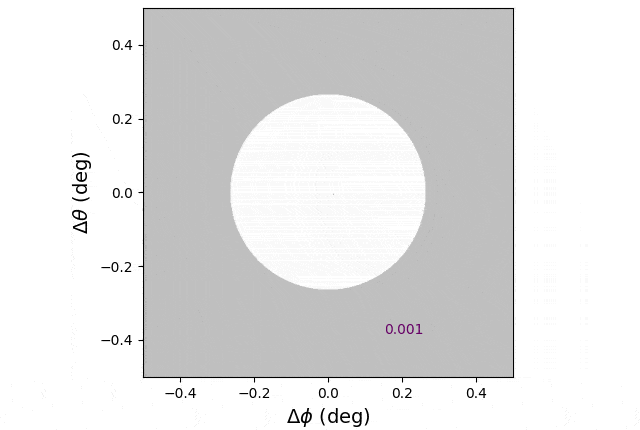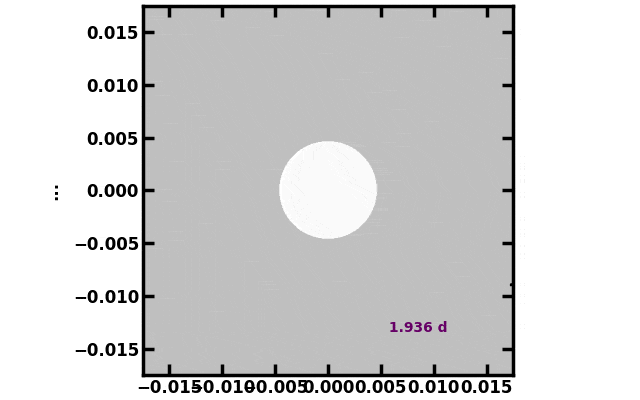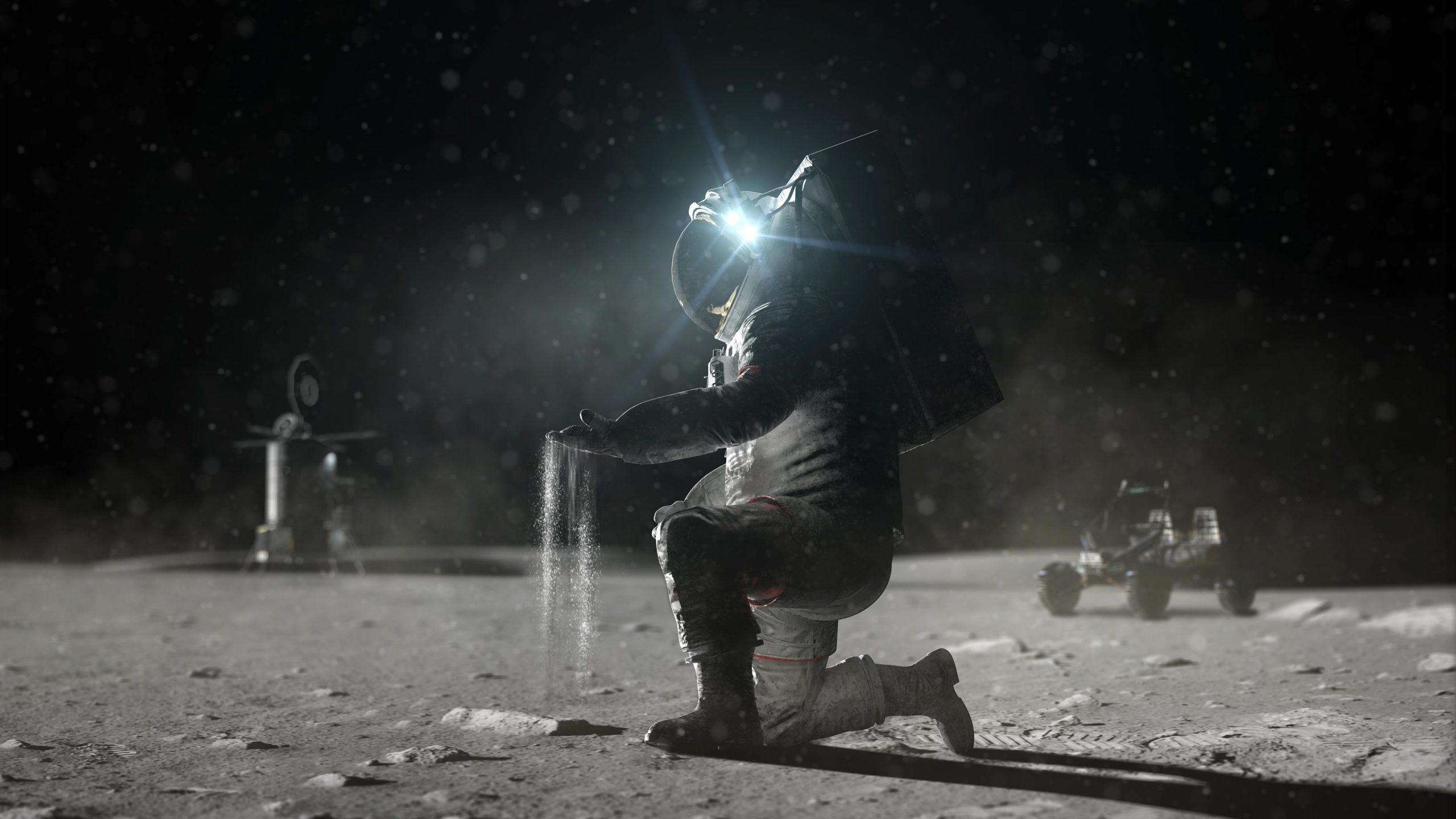
Un paisaje lunar polvoriento, visualizado por el Laboratorio de Conceptos Avanzados de la NASA. Crédito: NASA
En un día frío de invierno, la calidez del sol es muy bienvenida. Sin embargo, a medida que la humanidad libera más y más gases de efecto invernadero, la atmósfera de la Tierra atrapa más y más energía solar y calienta constantemente la Tierra. Una estrategia para revertir esta tendencia es interceptar parte de la luz solar antes de que llegue a nuestro planeta. Durante décadas, los científicos han considerado el uso de pantallas, objetos o partículas de polvo para bloquear suficiente radiación solar (entre el 1 y el 2 %) para mitigar los efectos del calentamiento global.
Un estudio dirigido por la Universidad de Utah exploró la posibilidad de utilizar el polvo para protegerse de la luz solar. Analizaron las diferentes propiedades de las partículas de polvo, las cantidades de polvo y las órbitas que mejor se adaptan a la sombra de la Tierra. Los autores encontraron que disparar polvo desde la Tierra a una estación en ruta en el “punto de Lagrangian” (L1) de la Tierra-Sol sería más eficiente pero requeriría un costo y esfuerzo astronómico. Una alternativa es usar polvo lunar. Los autores argumentan que la liberación de polvo lunar desde la Luna podría ser una forma barata y efectiva de ensombrecer la Tierra.

Liberación simulada de una corriente de polvo entre la Tierra y el Sol. Esta nube de polvo aparece cuando cruza el disco del sol, desde la Tierra. Corrientes como estas, incluidas las liberadas desde la superficie lunar, podrían actuar como un paraguas temporal para el sol. Crédito: Ben Bromley/Universidad de Utah
El equipo de astrónomos aplicó una técnica utilizada para estudiar la formación de planetas alrededor de estrellas distantes, que es su enfoque habitual de investigación. La formación de planetas es un proceso caótico que libera una gran cantidad de polvo cósmico que puede formar anillos alrededor de la estrella anfitriona. Estos anillos interceptan la luz de la estrella central y la vuelven a irradiar de una manera que podemos detectar en la Tierra. Una forma de descubrir estrellas que forman nuevos planetas es buscar estos anillos de polvo.
“Esa fue la semilla de la idea”, dijo Ben Bromley, profesor de física y astronomía y autor principal del estudio.

Simulación del polvo liberado desde la estación de paso en el punto 1 de Lagrange. La sombra en el suelo está exagerada para mayor claridad. Crédito: Ben Bromley
dijo Scott Kenyon, coautor del estudio del Centro de Astrofísica | Harvard y Smithsonian.
El artículo fue publicado recientemente en la revista PLOS clima.
proyectar sombra
La efectividad general del escudo depende de su capacidad para mantener una órbita que ensombrece la Tierra. Sameer Khan, estudiante de pregrado y coautor del estudio, dirigió la exploración inicial de que los orbitales podrían atrapar el polvo en una posición el tiempo suficiente para proporcionar una sombra adecuada. El trabajo de Khan demostró la dificultad de mantener el polvo donde se desea.
“Debido a que conocemos las ubicaciones y las masas de los principales cuerpos celestes de nuestro sistema solar, simplemente podemos usar las leyes de la gravedad para rastrear la posición simulada del escudo solar a lo largo del tiempo en varias órbitas diferentes”, dijo Khan.
Había dos escenarios prometedores. En el primer escenario, los autores colocan una plataforma espacial en el punto L1 Lagrange, que es el punto más cercano entre la Tierra y el Sol donde las fuerzas gravitatorias se equilibran. Los objetos en los puntos de Lagrange tienden a permanecer a lo largo de un camino entre dos cuerpos celestes, razón por la cual[{” attribute=””>James Webb Space Telescope (JWST) is located at L2, a Lagrange point on the opposite side of the Earth.

A simulation of dust launched from the moon’s surface as seen from Earth. Credit: Ben Bromley
In computer simulations, the researchers shot test particles along the L1 orbit, including the position of Earth, the sun, the moon, and other solar system planets, and tracked where the particles scattered. The authors found that when launched precisely, the dust would follow a path between Earth and the sun, effectively creating shade, at least for a while. Unlike the 13,000-pound JWST, the dust was easily blown off course by the solar winds, radiation, and gravity within the solar system. Any L1 platform would need to create an endless supply of new dust batches to blast into orbit every few days after the initial spray dissipates.
“It was rather difficult to get the shield to stay at L1 long enough to cast a meaningful shadow. This shouldn’t come as a surprise, though, since L1 is an unstable equilibrium point. Even the slightest deviation in the sunshield’s orbit can cause it to rapidly drift out of place, so our simulations had to be extremely precise,” Khan said.
In the second scenario, the authors shot lunar dust from the surface of the moon towards the sun. They found that the inherent properties of lunar dust were just right to effectively work as a sun shield. The simulations tested how lunar dust scattered along various courses until they found excellent trajectories aimed toward L1 that served as an effective sun shield. These results are welcome news, because much less energy is needed to launch dust from the moon than from Earth. This is important because the amount of dust in a solar shield is large, comparable to the output of a big mining operation here on Earth. Furthermore, the discovery of the new sun-shielding trajectories means delivering the lunar dust to a separate platform at L1 may not be necessary.
Just a moonshot?
The authors stress that this study only explores the potential impact of this strategy, rather than evaluate whether these scenarios are logistically feasible.
“We aren’t experts in climate change, or the rocket science needed to move mass from one place to the other. We’re just exploring different kinds of dust on a variety of orbits to see how effective this approach might be. We do not want to miss a game changer for such a critical problem,” said Bromley.
One of the biggest logistical challenges—replenishing dust streams every few days—also has an advantage. Eventually, the sun’s radiation disperses the dust particles throughout the solar system; the sun shield is temporary and shield particles do not fall onto Earth. The authors assure that their approach would not create a permanently cold, uninhabitable planet, as in the science fiction story, “Snowpiercer.”
“Our strategy could be an option in addressing climate change,” said Bromley, “if what we need is more time.”
Reference: “Dust as a solar shield” by Benjamin C. Bromley, Sameer H. Khan and Scott J. Kenyon, 8 February 2023, PLOS Climate.
DOI: 10.1371/journal.pclm.0000133

“Amante de los viajes. Pionero de Twitter. Ávido gurú de la televisión. Aficionado a Internet galardonado”.

